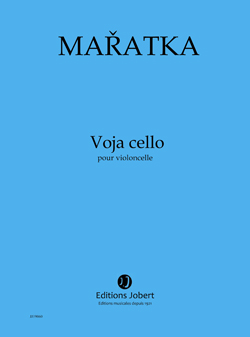VOJA CELLO
great solo for cello
inspired by gypsy music
(1999)

Movements:
- Gitaneon
- Ciganuška
- Rom
- Vjem Bohem
Duration: 25’
Premiere: François Salque (cello), Théâtre des Champs Elysées, January 2000
Publisher: The Henry Lemoine Editions display more information on this work on
http://www.henry-lemoine.com/fr/catalogue/compositeur/maratka-krystof
For more information, contact:
Henry Lemoine Editions – Paris
Mrs Laurence Fauvet - Rental and purchase of score
orchestre@editions-lemoine.fr / +33 (0) 1 56 68 86 75
Jobert Editions
Henry Lemoine Editions – Paris
Mr. Benoît Walther - Promotion and distribution service
bwalther@editions-lemoine.fr / +33 (0) 1 56 68 86 74
Jobert Editions
Recordings:
François Salque, cello
Extract from the score:
Notes on the work:
Voja Cello, great solo for cello, is inspired by Gypsy music, the originality of its musical language, its rich variety of interpretation and the spirit that animates it.
The work is divided into four contrasting parts (Gitaneon, Ciganuska, Rom, Vjem Bohem) linked together without interruption, and connected, despite their different characters, by the same internal tension. The titles are neologisms united by roots that refer to an ethnic group living in the diaspora: Gitanos, Gypsies, Roma or Bohemians.
The basic character of the 1st movement - Gitaneon - is formed by the instability of the tempo in combination with portamento and legato bow strikes and the brief appearance of a cantilena in an extremely high tessitura. The second movement - Ciganuska - is a kind of dance composed of many parts built on the principle of rhythm variations of a single melodic line. In the 3rd movement - Rom - the richness of the different sounds is pushed to the extreme: the cello becomes a percussion instrument, in its syntax and in the quick sequence of varied modes of play. When the density of energy reaches its peak, the gradation leads into the last movement - Vjem Bohem. Its song, of a plaintive but proud nature, rigid and intense, is exposed on the four strings forte and without vibrating, thus emphasizing its fierce character. A sudden contrast of dynamics announces the end of the work that finishes with the song of a “choir” of three voices (played on three strings simultaneously) which disappears gradually into silence.
Throughout the composition, the two middle strings of the cello must be lowered by a semitone. This scordatura creates a modal universe based on a F#, A, B#, C# chord, favouring intervals that characterize the minor gypsy mode (Hungarian mode).
The title of the work refers to the state of mind of a musician who plays improvisations of great virtuosity to encourage others to follow him. When everyone starts to sing and dance comes the moment of grace and ecstasy that leads the community to the much desired heavens: those of freedom.

